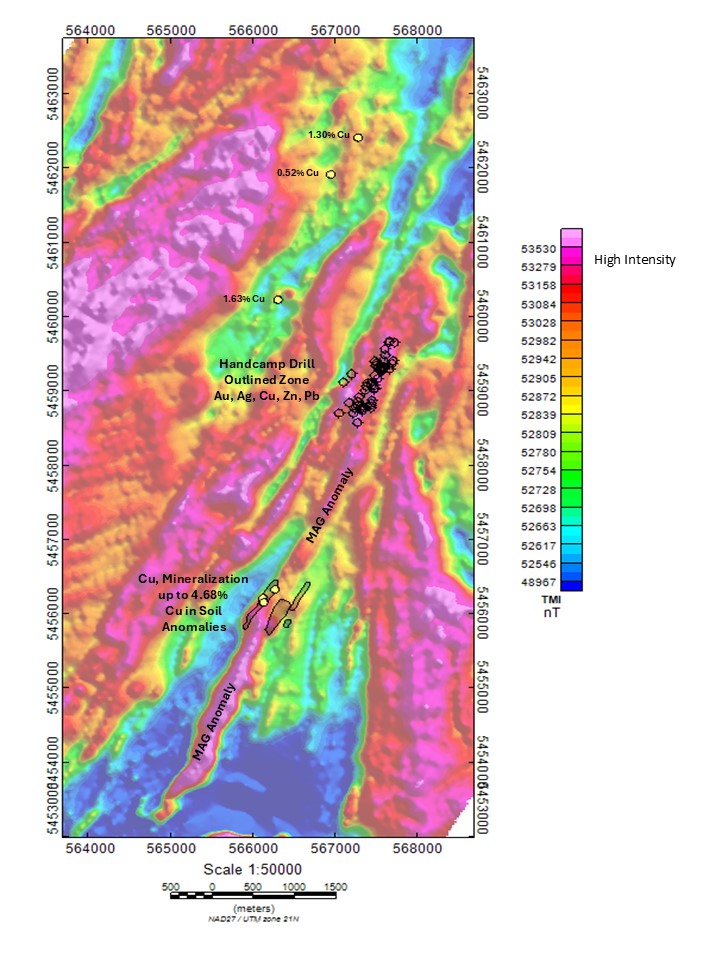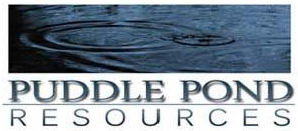- BY Crystal
- POSTED IN Company, News
- WITH 0 COMMENTS
- PERMALINK
- STANDARD POST TYPE
Puddle Pond Resources Inc. “the company”, is pleased to report latest fieldwork completed on it’s 100% owned Handcamp Project continues to produce positive results adding to the potential for this large 79 sq. km. project. The project is centered over and covers a 20 km section of the “Red Indian Line”, a major, regional lithotectonic boundary and transcrustal fault system. This north-northeast trending fault zone is one of several major fault systems in Newfoundland which are the focus of a high level of exploration activity generated by the recent discovery of New Found Gold’s Queensway Gold Project in central Newfoundland.
The latest fieldwork has delineated several Copper (Cu) soil anomalies and ore grade Cu assays in boulders of semi- massive to massive sulphide mineralization. These results are summarized and displayed in the map below.
- B Horizon soil sampling over 5 reconnaissance (recce) grid lines outlined 3 copper (Cu) soil anomalies along the zone of up to high grade (4.68%) Cu mineralized boulders reported June 21st. The grid lines cover a 750-metre section of a first order, highly magnetic MAG anomaly. These boulders aligned along the anomaly are also highly magnetic suggesting the anomaly may be the source of the Cu mineralization. This MAG anomaly detailed during earlier government airborne surveys is a well-defined linear zone, extending 7 kms north – northeast (030˚). Note: The Handcamp Zone also within this linear zone and located 3 kms to the northeast has been successfully drill tested with significant polymetallic (Au, Ag, Cu, Zn & Pb) mineralization intersected along a 850 m section, drilled to date (ref. earlier press releases on the Puddle Pond website).
The soil anomalies are strong, up to 6 times above the background Cu values and their alignment along the high MAG anomaly further defines this highly prospective, untested drill target.
- Prospecting directed by veteran prospector Fred Keats has identified another boulder zone of semi-massive to massive sulphide Cu rich mineralization yielding significant copper assays of 0.53 %, 1.30% & 1.63 % Cu, accompanied by silver values up to 5600 ppb (5.6 g/t) Ag and gold values up to 153 ppb Au. These boulders are to the northwest of the Handcamp Zone, and the 3 boulder sites discovered to date stretch 2500 m along another north-northeast (030˚) trending zone.

Surface surveys and diamond drilling at the Handcamp Zone since acquiring the Handcamp Project in 2021, and including these latest prospecting results confirm the polymetallic (more than 1 metal) mineralization on this strategically located project located along the TCH. To date the different metal assemblages include:
- Gold, silver, zinc, copper & lead (Au, Ag, Zn, Cu & Pb) in magnetic rocks at the drill tested Handcamp Zone.
- Cu (only) in magnetic rocks sited along the MAG linear also host to the Handcamp Zone.
- Cu & Au in non-magnetic rocks to the west of the MAG linear (reference earlier press releases on the Puddle Pond website).
- Cu, Ag & Au in weaker magnetic rocks to the northwest of the Handcamp Zone, just discovered.
The large Handcamp Project is within the highly prospective Buchans-Roberts Arm Belt of rocks host to the world famous Buchans Mine which over a 50 year mine life from 1927 to 1979 produced over 16 million tonnes of ore valued at $6.2 Billion. These Volcanogenic Massive Sulphide (VMS) deposits were polymetallic with Zn, Pb, Cu, Ag & Au averaging over 22% ore grades. Following this discovery, exploration throughout the belt of rocks resulted in the discovery of other significant mineral deposits.
These VMS deposits include the adjacent past producing Gullbridge Copper Mine immediately south which operated from 1967 to 1972 and is currently being explored by Champion Iron Mines, and the historical Lake Bond Zn, Cu (Au) deposit. This Lake Bond deposit also 100% owned by Puddle Pond Resources Inc. has been the site of historical drilling reported to host up to 4M tonnes of VMS mineralization and includes an historical resource of 1.2 M tonnes grading 2.12% Zn and 0.30% Cu. This project located 16 km south of the Handcamp Project covers a 9.5 km section of the Buchans-Roberts Arm Belt and Red Indian Line, positioning Puddle Pond as a significant stakeholder in this highly prospective belt of rocks and deep crustal structural zone.
Drilling permits have been approved by the Newfoundland Government for both the Handcamp and Lake Bond Projects. The company expresses it’s appreciation for this support which also includes approval for funding under their Junior Exploration Assistance Program administered by the Department of Industry Energy & Technology. The planned fall drilling programs qualify for flow through funding which allows investors to avail of the tax incentives offered by the Federal and Provincial Governments including incentives under the Critical Minerals program. These critical minerals at the Handcamp and Lake Bond Projects include copper & zinc, 2 of the important minerals on Canada’s Critical Minerals list.
Victor French, P. Geo., a Qualified Person as defined by NI 43-101 and President & COO for Puddle Pond, is responsible for the technical information contained in this News Release.
On Behalf of the Board of Directors
“Victor A. French”
1-709-786-7978
contactus@puddlepondresources.com
About Puddle Pond Resources Inc.: Puddle Pond Resources is a Newfoundland-based mineral exploration company (headquartered in Bay Roberts, Conception Bay) focused on the identification and development of undervalued mineral assets in the Province of Newfoundland & Labrador, one of the Fraser Institute’s top-10 mining jurisdictions in the world. The Company’s present foci are Orogenic Gold, Epithermal Gold-Silver, and Volcanogenic Massive Sulphide deposits. Presently, the Company holds the rights to more than 60,000 hectares (>675 km2) of mineral claims on the Island of Newfoundland, distributed amongst 14 individual properties that are situated in either the “Springdale – Baie Verte Mining District”, “Central Newfoundland Gold Belt”, and the “Avalonian Epithermal Belt”.


